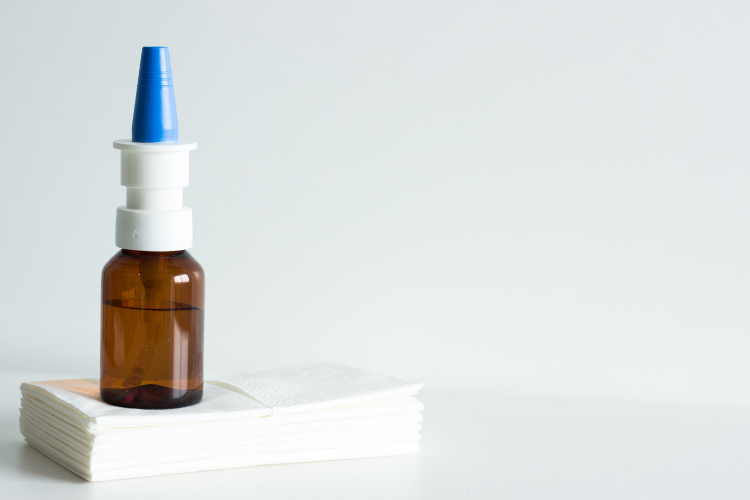Guest Post by Katy Fleming, MA, LPC, BSN, RN
During flu and allergy season, millions of adults and children struggle with sneezing and a stuffy nose.
If you’ve ever felt like your nasal spray wasn’t working or simply had difficulty utilizing it, you’re not alone. Some aren’t using these sprays correctly and may not realize it.

Founder of Dr. Noze Best and Pediatric ENT, Dr. Stephen Goudy explains the correct way to use nasal spray and identifies some common errors in this TikTok video.
Here's the Right Way to Use Nasal Spray (And Why Most People Use it Wrong)
We’ll break down Dr. Goudy’s expert advice below, so you feel relief from your nasal inflammation.
@drnozebest #greenscreen this is the right way to put nasal spray in your nose! A lot of people are doing it wrong and it’s not working for them as well as causing trauma and nosebleeds. #Nose #nasal #NasalSpray #Breathing #Allergies #Flonase #AllergyMedication #Congested #Boogers #Salinas, #Sinusitis, #ENT #FYP @@beachgem10@@thepedipals ♬ original sound - Dr. Noze Best
The Right Way to Use Nasal Spray
Many people don’t realize that they’re incorrectly using nasal sprays or giving children the wrong directions. Nasal sprays reduce congestion or stuffiness found with colds and seasonal allergies.
First, always ensure that you blow your nose to clear out mucus. Also, thoroughly wash your hands before starting to prevent the spread of germs.
Here are step-by-step directions on using nasal spray:
Step 1. Prime by Pumping the Applicator
Check the box for the manufacturer’s directions. Some nasal sprays require priming before usage.
If your nasal spray needs primed— first gently shake and then squeeze the bottle. Once you see a mist coming out, it’s ready to go!
Step 2. Tilt Your Head Forward
Sit down in an upright position and tilt your head forward.
Step 3. Point Nozzle Tip Toward Outside
Place the nozzle tip into one nostril of your nose or your child’s nose. Be sure to face the tip towards the outside of your nose. You want the spray to go into the sinus cavity.

Check out the guide below:
Common Errors
Several misconceptions arise with nasal spray. Let’s review typical mistakes to verify that you’re getting all your nasal spray.
Aiming towards your septum
A key factor in the effectiveness of nasal spray is your aim. Many people direct the tip towards the wall inside their nose or the nasal septum. It doesn’t wash out your nose correctly and can even result in blood.
Immediately blowing your nose AFTER using nasal spray
It’s helpful to clear your nose before using a nasal spray. However, you want all the medicine to stay in your sinuses, so it’s important to avoid blowing your nose afterward.
Tilting your head backward
We often gravitate towards leaning our heads back in these situations. The main issue is that the medicine is needed in your sinuses. If you tilt your head backward, the spray will drip down the back of your throat.
Sharing with family and friends
In many instances in life, sharing is spreading kindness. When it comes to nasal sprays, sharing is never caring. This spreads bacteria and illness.

Final Thoughts
Different types of nasal sprays are used. Steroid and antihistamine nasal sprays help with seasonal allergies. Steroid sprays are available over-the-counter whereas antihistamine nasal sprays require a prescription from a medical professional.
For the cold and flu season, decongestant nasal sprays are also available without a prescription. It’s important to only use decongestants for a few days in a row. After 3 or 4 days, you can build up a tolerance.
Utilize Dr. Goudy’s steps to ensure that you’re using nasal sprays the right way. Clear out your nasal congestion with this easy guide!
Looking for more info about managing seasonal allergies? Try these:
- How Do Seasonal Allergies Differ Between Babies And Toddlers?
- Can Babies Have Seasonal Allergies?
- Why Are Allergies Worse At Night?
- Spring Allergies Are Here: What Parents Need To Know
- 6 Foods That Help Calm Seasonal Allergies (That Even Your Toddler Will Love)
As a licensed counselor and registered nurse, Katy approaches freelance writing with years of experience and a unique perspective. Alongside her partner, Katy loves to travel the world and embrace other cultures from volcanoes in Iceland to villages in India.
The Nozebot is a battery-powered suction device designed to clear nasal congestion in babies and children.



